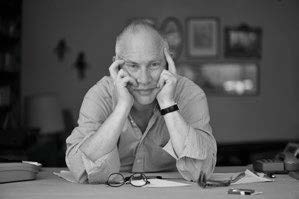 Christopher Butterfield lives in Victoria BC, where he teaches composition in the School of Music at the University of Victoria. Career highlights include conducting the first Canadian west coast performance of Pierre Boulez’ “Le Marteau sans maître” on Hornby Island in 1995; performing Kurt Schwitters’ “Ursonata”on tour with the Bill T. Jones/Arnie Zane Dance Company in the US and Europe in 1996/97; the production of his opera on dada and communism, Zurich 1916, at the Banff Summer Festival in 1998; composer-in-residence with the Victoria Symphony 1999-2002; the premiere of his score for Bill Coleman’s dance epic “Convoy PQ17” in St. Petersburg, Russia in 2001 (remounted in Victoria in 2013); the first performance of his complete settings of Jacques Prévert’s “Contes pour enfants pas sage”s in Toronto by Continuum Contemporary Music and Choir 21 (2012). Recent activities include co-ordinating and curating the Cage 100 Festival in Victoria (2012), celebrating American composer John Cage’s centenary; and judging the International Gaudeamus Composition competition in Utrecht, Netherlands (2012), where “Bosquet”, his piece for 22 flutes and 1 ‘cello, was performed.
Christopher Butterfield lives in Victoria BC, where he teaches composition in the School of Music at the University of Victoria. Career highlights include conducting the first Canadian west coast performance of Pierre Boulez’ “Le Marteau sans maître” on Hornby Island in 1995; performing Kurt Schwitters’ “Ursonata”on tour with the Bill T. Jones/Arnie Zane Dance Company in the US and Europe in 1996/97; the production of his opera on dada and communism, Zurich 1916, at the Banff Summer Festival in 1998; composer-in-residence with the Victoria Symphony 1999-2002; the premiere of his score for Bill Coleman’s dance epic “Convoy PQ17” in St. Petersburg, Russia in 2001 (remounted in Victoria in 2013); the first performance of his complete settings of Jacques Prévert’s “Contes pour enfants pas sage”s in Toronto by Continuum Contemporary Music and Choir 21 (2012). Recent activities include co-ordinating and curating the Cage 100 Festival in Victoria (2012), celebrating American composer John Cage’s centenary; and judging the International Gaudeamus Composition competition in Utrecht, Netherlands (2012), where “Bosquet”, his piece for 22 flutes and 1 ‘cello, was performed.
Over the years, Christopher has been the recipient of many commissions from the Canada Council for the Arts, and the Ontario and BC Arts Councils. Current projects include translating Théatre by Paris Dada Georges Ribemont-Dessaignes for publication by the Wakefield Press in fall 2014.
“Parc was commissioned by Aventa Ensemble for percussionist Rick Sacks. I met Rick in 1975 when I went to graduate school at SUNY Stony Brook, on Long Island. In late 1979, he came to Toronto to play drums in Klo, a band my brother Philip and I had started. It was supposed to be a temporary engagement, but he’s still in Toronto. In the late 80’s I wrote a piece called ‘Music for Klein and Beuys’. There’s a section played on five pieces of wood, a pattern which I’ve lifted and used for this piece. “Parc” opens with the pattern assigned to pitches on the vibraphone – after a short interlude by the ensemble, it returns to its original setting, for pieces of wood, and settles in for a lengthy solo. The next section leaves this material behind completely, moving to a kind of helter-skelter moto-perpetuo. (At the time we were graduate students, there was a vogue for solo multiple percussion pieces, which required a similar kind of virtuosity). This, in turn, gives way to a pulsing music for the ensemble, in which rapidly changing dynamics in each part create an unstable texture.
A short vibraphone solo to be played ‘with love’ follows, and the piece closes with the ensemble searching for an ending – there are 3 possible passages to close, which are decided on by the conductor. “Parc” could be: Mont-Royal. Lafontaine. Belmont. High. Pkols. Beacon. Mt. Tolmie. Stanley. Holland. Green. Hyde. Kew. Central. Fort Tryon. Battery. Buttes-Chaumont. Monceau. Villa Medici. Boboli. Vondel. Englischer. Tier. Or maybe the Grand Hotel du Parc, in Villars, Switzerland.” – Christopher Butterfield Photo credit: Ken Straiton
